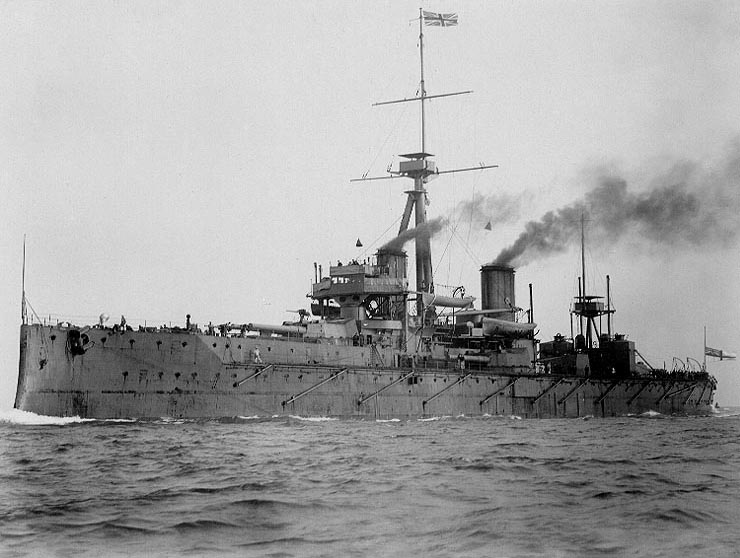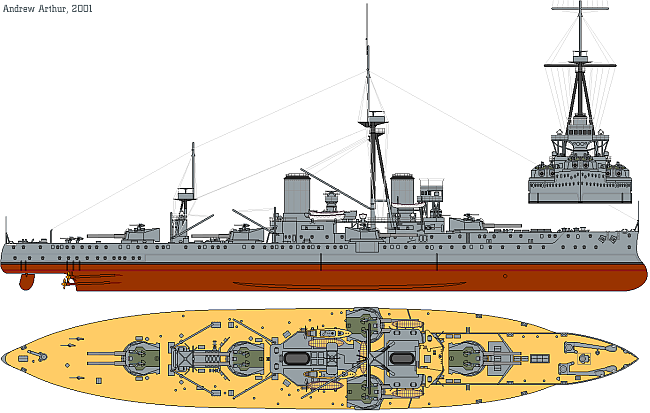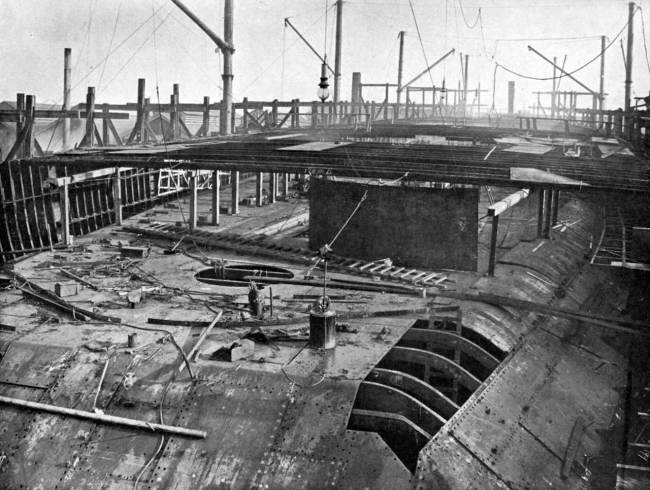In early 1907, the battleship HMS Dreadnought sailed on her shake-down cruise to the Caribbean under Captain Reginald Bacon. She was a remarkable vessel in many ways, one whose name became synonymous with all battleships during the First World War period, and whose ‘all big-gun’ concept set the pattern for every battleship that followed. However, just how much influence did this remarkable warship truly have? Was she a revolution or evolution of warship design?
Admiral of the Fleet Sir John Arbuthnot Fisher (1841-1920).
The ship was popularly portrayed at the time as a wonder-vessel, brain-child of the First Sea Lord, Admiral Sir John Fisher – along with its cruiser equivalent, the battlecruiser. According to Fisher, the Dreadnought was a revolutionary step he conceived with input from the Constructor at Portsmouth dockyard, H. H. Gard, built in just a year and a day, making every earlier battleship instantly obsolete. There was only one small problem: it wasn’t strictly true. The forces driving Dreadnought‘s origin were as much political and economic as technical, and because the final outcome was a result of the mix between all these factors – into which Fisher’s persona stirred colour and controversy – the issue has been open to historical discussion since, largely in terms of how all these issues inter-played. Indeed, the way these events are understood has gone through repeated re-interpretation since 1929, when Bacon published his biography of Fisher. The subsequent main interpretation, proposed in the 1960s by US academic Arthur Marder, has also been debated. Ongoing and constructive discussion is, of course, the essence of how historical understanding emerges.
One point that has emerged from this process is that we have to draw distinction between the popular view of Dreadnought as a pivot, and her place in terms of broader historical social, political and engineering trends. Dreadnought had many innovations and advantages, but she was not quite the total conceptual revolution that Fisher liked to make out. The point arguably had a good deal to do with his ego. He wanted to be seen as innovative and influential; but Dreadnought was more an evolutionary extension of existing trend, including the nature of her armament, and behind the scenes he did not get his way with the actual revolution he wanted – which was to scrap battleship construction in favour of large and fast armoured cruisers.
To explore how all that worked, we first need to look at the way battleships were evolving up to that time. By the 1890s, battleship design had emerged from a long experimental period characterised by fast technical change, and was producing ships of about 12-15,000 tons with reciprocating engines, capable of 15-17 knots and typically with four heavy guns, backed by lighter weapons. That concept continued to evolve around these broadly established engineering themes. Speed, displacement and fire-power crept up as technology was further refined, all framed by politics and funding along with a variety of engineering and infrastructure constraints. The United States Navy led the way by adding 8-inch weapons to supplement heavy guns on their battleships, starting with their Indiana (BB1) class of the mid-1890s. The British were late to the party, not adding intermediate guns until the eight King Edward VII’s, which were laid down in 1903-04 and carried four Mk X/47 calibre 9.2-inch guns in addition to four 12-inch and a dozen 6-inch. A larger battery of intermediate weapons was considered, but the time to design the ships would have been extended and the idea was rejected. However, the next class, the two Lord Nelsons, did away with 6-inch and carried four Mk X/45 12-inch and ten Mk IX/50 9.2-inch, in turrets.[1]
This was reasonable. At the expected battle ranges of around 3000 yards, the 9.2-inch gun was regarded as effective against any vessel. The Mk X/47 calibre version, deployed on the King Edward VIII class,[2] could penetrate typical battleship armour of the day at that distance. However, as ranges increased, penetration figures dropped. It also became difficult to tell the difference between 9.2-inch shell splashes and those of the 12-inch armament, making fire-control problematic with the available systems of 1903-04. The more crucial issue was that by this time battleship scale had grown to 16-17,000 tons, speeds were topping 18 knots, and designers from the US to Japan were looking at ways of further upping the fire-power, for which the obvious answer was increasing the number of main-battery guns. This was bandied about in the naval press of the day, such as Jane’s Fighting Ships, where Italian designer Vittorio Cuiniberti proposed an ‘ideal’ battleship for Britain with an all-12-inch armament. He is often upheld as one of the factors behind Dreadnought; but in reality his thinking echoed decisions already made in the British Director of Naval Construction’s department, who also believed a single large-calibre main battery was the only option.
Vittorio Cuiniberti’s ‘ideal battleship’ of 1903.
Nevertheless, there were several false starts, both in Britain and elsewhere, in which the limiting factors were usually cost. In 1904, the new British Director of Naval Construction (DNC), Phillip Watts, contemplated an all-12-inch armament for the Lord Nelsons before settling on mixed armament. Meanwhile the Japanese designed the Satsuma with a dozen 12-inch weapons in the Cuiniberti layout, although supply difficulties and cost led to her being completed instead with four 12-inch and a dozen 10-inch. Meanwhile, US designers came up with the South Carolina, of similar displacement to the earlier Connecticut class for cost reasons, but with eight 12-inch guns and no intermediate battery. All these ships were in development when Fisher’s 14-member Committee on Designs was appointed on 22 December 1904. It comprised the Controller – John Jellicoe – and others, including members of the DNC’s department. Fisher was chairman but not a member, and they convened in context of a request to reduce the naval estimates. They were also briefed, on the back of Fisher’s lobbying, to produce designs for an all big-gun battleship and armoured cruiser, along with designs for new torpedo boats.[3]
HMS Agamemnon of the Lord Nelson class, showing her intermediate armament of 9.2-inch guns in side-mounted turrets. Public domain, via Wikipedia.
The remarkable aspect of this Committee’s work was not so much the slenderness of their final report as the speed with which they produced designs for the new battleship and armoured cruiser – all devised, in sketch, in just seven weeks and ten meetings from January 1905. This underscored the fact that thinking was already well advanced along these lines. Fisher was enthusiastic for the super-scale cruiser, but not the battleship, justifying his stance on the basis that new armour-piercing shells had rendered armour obsolete; it could be reduced or dispensed with and the real focus had to be speed. His views have typically been described as ‘confused’ during this period, but there is some evidence – proposed by one of his biographers, Ruddock MacKay – that Fisher was navigating politics and what he really wanted was the new armoured cruiser type, replacing all battleships, in part as a cost-cutting measure.[4] In that calculation he seems to have considered that the fire-control systems emerging in 1904-05 would give his cruisers the edge.[5] However, this was just too radical for the Admiralty. It is a salutary expression of the politics involved that while one battleship and three of Fisher’s super-scale armoured cruisers – the Invincible class – were authorised on the back of the Committee’s work – only the battleship was prioritised, and later annual programmes usually ran the types in a 3:1 ratio, favouring the battleships.
In short, Fisher did not wholly get his way: and if we consider Fisher’s armoured cruiser ideas as the ‘revolution’, then in many ways Dreadnought was more ‘evolution’. As we have seen, the all-big-gun armament was entirely in line with existing trend. Furthermore, battleship size, speeds and broadside weights had been rising since the 1880s, and Dreadnought was very much on the curve. Thanks in part to cost constraints – but also docking limits, which constrained size – she was not radically larger than the Lord Nelson class – 17,900 tons normal load versus the Lord Nelson’s 15,925 tons. This was a lesser jump than between the 12,590 ton battleship Nile of 1888 and the 15,580 ton displacement of her successor Royal Sovereign class of 1889. Further, Dreadnought’s broadside at around 6,600 lb was not radically heavier at intended battle range than Lord Nelson’s 5,200 lb.[6] Technically, the more decisive jump in battleship power came in 1908-09, when the British introduced the 13.5-inch gun and new armament distribution, creating what were soon dubbed ‘super-dreadnoughts’. At around 12,500 lb, the design broadside weight of the first, HMS Orion, was a dramatic step up from the 8,500 lb of her predecessor, HMS Neptune.[7]
HMS Dreadnought after a 1911 refit. Public domain, via Wikipedia.
The point that Dreadnought was an evolution that embodied current trends – not a total re-think – was generally recognised within the Admiralty. There were even calls to build more Lord Nelsons, which were liked in service for their handling, and also regarded as effective combatants for some years. Even during the First World War, the pair were stationed off the Dardanelles where they were thought sufficient, together, to tackle the battlecruiser Goeben. Indeed, because of the way equipment was made available, the fit-out on some later ‘pre-dreadnoughts’ occasionally involved newer equipment than that of Dreadnought, as when the Lord Nelsons were fitted with a signalling system to indicate guns were ready and the target visible.[8]
So how did Dreadnought give her name, as a type, to every subsequent all-big-gun battleship? Arguably there were three main reasons. The first was that she did have one huge, radical and risky innovation: she was the world’s first turbine-driven battleship. The power-to-weight advantages of turbines became one of the reasons why it was possible to power the ship for 21 knots and carry ten 12-inch guns on 17,900 tons. However, it was a bold step; turbines were a new technology that had not been proven for large ships. They were also less efficient, fuel-wise, than older reciprocating engines. But the gamble paid off.
The second is that, chronologically, Dreadnought was the first of the new all-big-gun ships at sea. Despite Fisher’s hyperbole about a ‘year and a day’, Dreadnought was actually completed in fourteen months from keel-laying. That was still a tremendous achievement. Legend has it that this was achieved in part by appropriating the four main armament mountings intended for the two Lord Nelsons. [9] However, this is not quite correct: in fact, the mountings (‘turntables’) for the Lord Nelsons were ordered on 8 December 1904, those for Dreadnought on 6 January 1905. But the orders were then exchanged.[10] Exactly why is unclear; on those timings, the Lord Nelson class mountings would not have been much more advanced than those of Dreadnought. However, it is possible that Fisher – who had his ‘year and a day’ build-time in mind – felt even a few weeks’ advantage was worth it. The timing of the original Dreadnought order is salutary: the Committee had only just begun meeting and, although they had convinced Fisher not to go for 10-inch weapons, were unsure of the final number of 12-inch guns. However, the limiting time factor in construction was always the gun mountings – and irrespective of the final armament, Dreadnought was going to need a lot of them by prior standards. Such timing underscores the depth to which the decision to introduce such a ship had penetrated both the Admiralty and, by extension, Cabinet – again showing that Fisher was not the sole actor.
Although, as we have seen, Fisher’s propaganda about a ‘year and a day’ construction time was untrue, the ship was still built incredibly quickly, and for good reason. Politically, speed of construction was everything. It meant that Dreadnought overtook the American and Japanese ships already under development, while blind-siding the Germans who were emerging as a likely enemy. And it was a practical demonstration of just how good Britain’s ship-building industry was – a coup when industrial-economic rivalry, usually proxied through naval construction, was in full swing as an expression of national power. Indeed, Dreadnought was pushed through so quickly that her completion date – December 1906 – came ahead of the two Lord Nelsons and in the same month as the Hibernia, a King Edward VII class battleship of two classes earlier. The task involved over 1100 men and was achieved largely on the back of an enforced 69-hour working week.
HMS Dreadnought under construction – just 36 days after keel laying in October 1905. Public domain, via Wikipedia.
Into this mix also has to be layered a third factor – Fisher’s propaganda machine. He was a master at framing public opinion and sold the new warship as a miracle weapon, built in double-quick time. A good deal of this was hyperbole, but it gained popular traction at a time when matters military – and especially the hardware – were at the forefront of public attention, symbols of national power and security. It also came at a time when whatever was ‘new’ was also popularly regarded as rendering anything ‘old’ obsolete.
In short, for the general public – and reflected back into the ‘naval establishment’ to some extent – all the different aspects of the Dreadnought as something new struck chords with prevailing popular concepts ranging from ‘progress’ to social militarism – the way in which military hardware and people had become popularised as symbols of national identity, power and capability. In this circumstance it was perhaps inevitable that Dreadnought was going to be popularly uplifted as the pinnacle of all that mattered; and that was why Dreadnought was picked in 1910 by Horace de Vere Cole as target for a prank visit by the ‘Abyssinian’ royal family – actually Cole and his friends from the Bloomsbury Group, a collection of intellectuals and writers, suitably dressed up.[11]
This heady mix of social priority, Fisherian propaganda and the way national rivalries were brewing soon led to naval strength being popularly gauged solely in terms of the new all big-gun type which, inevitably, gained the generic name ‘dreadnought’. And when by 1908 it appeared – wrongly, as it turned out – that Britain might fall behind in the building race with Germany, there was a public outcry. Cooler heads prevailed in the Admiralty of 1908-09, where the vast fleet of earlier-style battleships, notably the more recent ones, was still regarded as effective in many circumstances. But that did not suit the public, underscoring the power of Fisher’s propaganda skills when promoting HMS Dreadnought as a wonder vessel.
For more on naval history, check out my book The Battlecruiser New Zealand: a Gift to Empire. Click to buy.
For more articles by me on the Navy General Board website, check out my article on the importance of submarines or my piece on why many warships were never built.
Copyright © Matthew Wright 2018
Notes
[1] For summary details see, e.g. Roger Chesneau and Eugene M. Kolesnik (eds), Conway’s All The World’s Fighting Ships 1860-1905, Conway Maritime Press, London 1979, pp. 38,40, 140-144.
[2] Rounded up, actual calibre was 46.7.
[3] Jon Tetsuro Sumida, In Defence of Naval Supremacy: Finance, Technology and British naval supremacy 1889-1914, Routledge, London 1993.
[4] Ruddock F. Mackay, Fisher of Kilverstone, Clarendon Press, Oxford 1973, pp, 321-32 .
[5] See, e.g. Jon Tetsuro Sumida, ‘British capital ship design and fire control in the Dreadnought era: Sir John Fisher, Arthur Hungerford Pollen, and the Battle Cruiser’, Journal of Modern History, Vol. 51, June 1979, pp. 205-230. Note spelling of ‘Battle Cruiser’.
[6] Depending on mark of shell, e.g. the APC Mk VIa was 859.4lb vs 850lb of the Mk VI. See http://www.navweaps.com/Weapons/WNBR_12-45_mk10.php, and http://www.navweaps.com/Weapons/WNBR_92-47_mk10.php, accessed 28 July 2018.
[7] Figures from http://www.navweaps.com/Weapons/WNBR_135-45_mk5.php
[8] Noted in http://dreadnoughtproject.org/tfs/index.php/Lord_Nelson_Class_Battleship_(1906)#12-in_Guns
[9] Suggested by Norman Friedman, The British Battleship 1906-1946, Seaforth, Barnsley 2015, p. 94.
[10] http://dreadnoughtproject.org/tfs/index.php/H.M.S._Dreadnought_(1906)
[11] They included New Zealand author Katherine Mansfield, although she was not part of the ‘Dreadnought hoax’.








Recent Comments